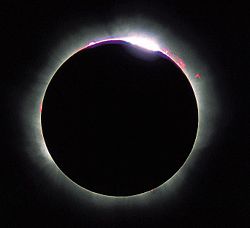 Two natural phenomena, a total lunar eclipse and supermoon chime together. The moon, earth and sun will be on one line this weekend for this year's total lunar eclipse and next year. At the same time, the moon will be in a position that is so close to the earth and looks slightly larger and brighter than usual or known as the supermoon phenomenon. This lunar eclipse will start on Sunday night or early Monday, depending on location, and will last around three hours. This phenomenon will start with a partial lunar eclipse at around 10:34 a.m. EST (east coast of America) on Sunday. At that time the shadows of the earth began to cover the moon. The total lunar eclipse when the earth's shadows cover the moon completely will last for 62 minutes, starting at 11:41 a.m. EST Sunday. - Warriors
Two natural phenomena, a total lunar eclipse and supermoon chime together. The moon, earth and sun will be on one line this weekend for this year's total lunar eclipse and next year. At the same time, the moon will be in a position that is so close to the earth and looks slightly larger and brighter than usual or known as the supermoon phenomenon. This lunar eclipse will start on Sunday night or early Monday, depending on location, and will last around three hours. This phenomenon will start with a partial lunar eclipse at around 10:34 a.m. EST (east coast of America) on Sunday. At that time the shadows of the earth began to cover the moon. The total lunar eclipse when the earth's shadows cover the moon completely will last for 62 minutes, starting at 11:41 a.m. EST Sunday. - Warriors If the weather is sunny, the entire lunar eclipse will be seen in North and South America, as well as in locations such as Greenland, Iceland, Ireland, the United Kingdom, Norway, Sweden, Portugal and beaches in France and Spain. Other European regions, as well as Africa, will be able to see a partial eclipse before the moon disappears behind the clouds. During the total lunar eclipse, the moon will look reddish because sunlight reflects off the earth's atmosphere. This is why sometimes a lunar eclipse is sometimes called the blood moon. In January, the full moon is sometimes also called the wolf moon or the big spirit moon. The informal term, the upcoming lunar eclipse will be called the super blood wolf moon or the big spirit moon. Quoted from page timeanddate.com, the total lunar eclipse can be seen clearly in Northern Europe, South America, Africa, and parts of Asia. Unfortunately the total lunar eclipse turned out to not be witnessed from Indonesian earth. - Tammy Faye Bakker
In the US, the lunar eclipse will start quite early on Sunday night, so children can watch it and look at this natural phenomenon. In addition the following day was a federal holiday, and most schools were closed. But the weather forecast for most parts of the US is not good. Asia, Australia and New Zealand were not lucky this time. But they had a special opportunity last year, when there were two total lunar eclipses. The total lunar eclipse will not occur again until May 2021. While for the full moon which is in the supermoon category, this will be the first supermoon phenomenon of three similar phenomena that will occur this year. The next supermoon phenomenon will occur at a distance of 357,300 km. Supermoon which occurs on February 19 will look a little close while what happens in March will be the furthest. - Jason Van Dyke